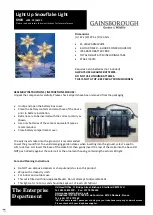
7
11 Troubleshooting Guide
Trouble
Reason
How to fix
Cannot calibrate
Poor quality standard
solutions
Replace with fresh and clean standard calibration
solutions made by legitimate scientific instrument
manufacturers.
Contaminated probe
Clean the probe with
Apera’s cleaning solution or
detergent water.
Aged probe
Replace the probe.
Dried-out probe
Soak the probe in clean water for 30 minutes.
Probe is not fully
submerged in the
solution
Make sure the probe is fully immersed in the solution at
least 1 inch deep.
Air bubbles around the
sensor
Make a quick stir in the solution to remove air bubbles.
Reading is always
slowly changing,
won’t stabilize
.
Contaminated probe
Clean the probe with
Apera’s cleaning solution or
detergent water.
Aged probe
Replace the probe.
Display similar
readings in any
solutions
Broken probe
If you
don’t find any visible damage of the probe and it’s
within the 1-year probe warranty, contact your point of
purchase for warranty fulfillment;
If there is visible
damage or the probe is more than 1-year old, replace
the probe.
Reading keeps
jumping
Probe is not fully
submerged in the
solution
Make sure the probe is fully immersed in the solution at
least 1 inch deep.
Air bubbles around the
sensor
Make a quick stir in the solution to remove air bubbles.
Probe is not properly
connected, or the pin
connector is broken.
Check the
probe’s connector, make sure it’s not broken
and is correctly connected. Align the probe and
instrument correctly before plugging in.
Never force it.
Ensure that the probe connector is not exposed in the
air too long.
Calibration is
successful, but
reading is not
accurate
Aged probe
Replace the probe.
Air bubbles around the
sensor
Make a quick stir in the solution to remove air bubbles.
Comparison with other
testers
To compare with other testers, make sure to perform
calibration for all testers in the same standards, then
test a 2nd point. Whichever gives more accurate
reading in the 2nd point standard is the most accurate
one.






























